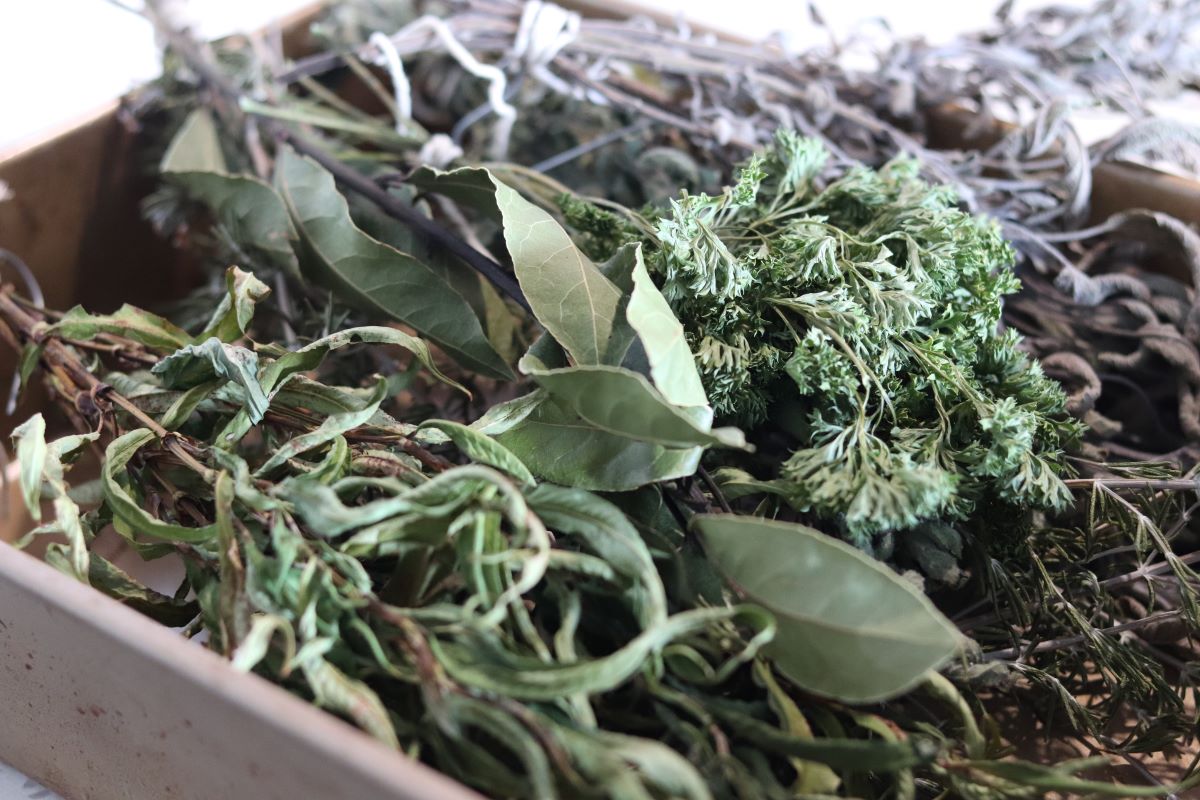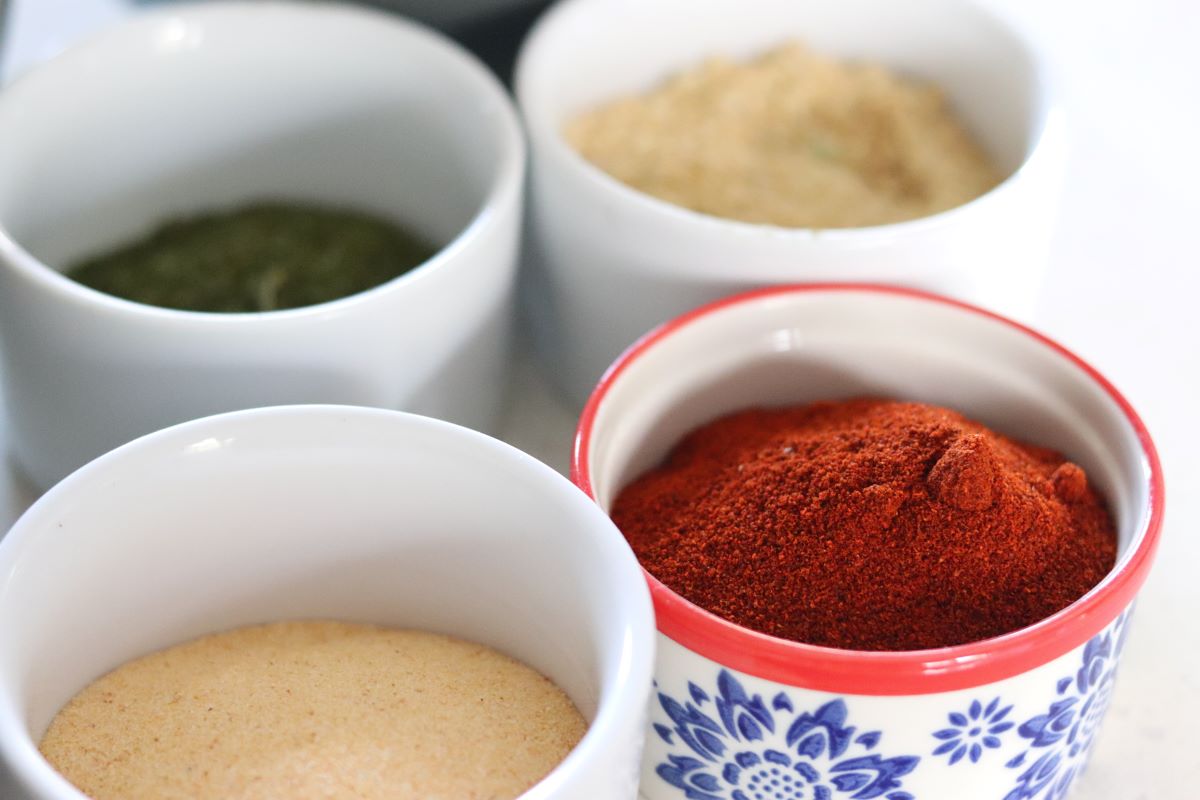Once you’ve made a batch of Homemade Flavoured Salt you’ll not want to use ‘standard salt’ again!
The beauty of homemade flavoured salts is that there is no real recipe – although there are guidelines and methods to take note of.
This is a particularly wonderful use of excess herbs in your garden. Depending on your climate, some herbs will only be in abundance at certain times of the year. Plants may ‘bolt’ and go into flower, and those that are less hardy may be susceptible to by a frost. Make the most of the season when you have it!
Homemade flavoured salt is delicious on and in just about everything – rubbed onto meat, sprinkled over roast vegetables, in a soup or casserole, or even simply on a cooked breakfast. A jar also makes a very thoughtful gift for a foodie in your life.
While you can make herbal salt with fresh herbs, my personal preference is to use dehydrated herbs. It’s so easy to make, can be used instantly, and you can add spices and other flavours too! If that sounds like you, make sure you read to the end!

What type of salts are good to use for Flavoured Salt?
I have used a variety of salts over the years, including:
- fine sea salt
- fine pink Himalayan salt
- flake salt
- Kosher salt
- …and good old table salt
Each type of salt will have it’s own flavour profile and texture. If you opt for a coarse salt you’ll need to put it in the food processor (at some stage of the process) so it is less ‘rock like’ and easier to sprinkle.

What herbs are best to use for Flavoured Salt?
You can use fresh herbs to blend with salt (thus the flavours infuse into the salt grains/flakes) then allow the mix to dry, or you can combine dehydrated herbs so they blend with the salt.
Just about any herb will work in this herbal mix. You can use everything you have at hand, or you can custom your mix to taste. This list is purely for inspiration – feel free to experiment with other herbs.
- parsley
- rosemary
- thyme
- tarragon
- sage
- basil
- dill
- oregano
- mint
- coriander
- chives
- bay leaves (sparingly)
Method for using Fresh Herbs
While the recipe is very adaptable, you may want to start with 3 cups of a mix of chopped fresh herbs to 1 cup of salt.
- Wash fresh herbs thoroughly and remove any course stems as this will add bitterness to the salt. Pat dry leaves between clean tea towels or paper towels. Roughly chop them and use a food processor or kitchen whizz to blend finely.
- Scoop out the wet herb mix and transfer into a bowl. Add salt, and mix thoroughly – and let the natural flavouring from the herbs infuse into the salt. NOTE: if you have opted to use a coarse grind of salt, you may wish to food process both the herbs and salt together – the idea is that you want to be able to sprinkle the salt on your meals by using your fingers and not breaking a tooth when eating!
- Transfer the fresh herb salt onto baking paper, spreading it out in a thin layer and allow to dry for several days at room temperature (or alternatively in a food dehydrator).
- Once dried, it may need breaking up or put back into the food processor (in case it has stuck together in a clump while drying). If it is looking a little too green (as the fresh herbs will colour the salt) add a little extra dry salt and mix through, if that is your preference.
- Store in an airtight container.
Method for using Dehydrated Herbs
This method is my personal favourite as I always have dried herbs hanging in my kitchen. In their ‘whole’ state, dried herbs will take up a similar capacity to fresh herbs – so use the 3 cups whole dried herbs to 1 cup salt as a guide. To be honest, I don’t even measure the herb quantities these days – the more the merrier, I reckon. I do ensure that there’s a mix of herb varieties though, so no one herb flavour overpowers the other.
TIP: Roughly one cup of dried herbs equates to around 2 tablespoons once it has been finely blitzed or powder. Once you start blending, you can add more herbs or more salt, to taste.
This also is a great opportunity to add spices! I’m such a fan of this. The mix of herbs and spices together is just divine. You’ll want to sprinkle it on absolutely everything! As all ingredients are dry, they can be blended and stored in an airtight container straight away.

Spices that work well include (all or some): chilli flakes, ground cumin, smoked paprika, allspice, garam masala, curry powder and ground black pepper. Additional flavours that also can be added include (all or some): onion powder, garlic powder, celery powder, dried lemon zest/powder.
How to Make Flavoured Salt
Ingredients
- Herbs
- Spices
- Salt
Method
- Start by measuring 1 cup of your chosen salt into a bowl. You can always add more later.
- Add 3 cups of dried whole herbs (or around 6-8 Tablespoons if they are already crushed or powdered). If you feel like adding more, do – it’s your recipe, your rules!
- If using ground spices or additional flavours, I suggest adding a tablespoon at a time for mellower flavours (such as onion powder and paprika), however you may wish to start with a teaspoon of the more pungent flavours (such as chilli flakes).
- There actually are no rules – but take a note of what you’ve added and how much (in case you want to replicate it again later, or adapt it later). You can always add more salt.
- Store in a sterilised clean air-tight jar.




